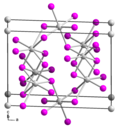Sn2+ (I−)2 | |
| Names | |
|---|---|
| IUPAC name tin(II) iodide | |
| Other names stannous iodide | |
| Identifiers | |
3D model (JSmol) | |
| ChemSpider | |
| ECHA InfoCard | 100.030.594 |
| EC Number |
|
PubChem CID | |
| UNII | |
CompTox Dashboard (EPA) | |
| |
| |
| Properties | |
| I2Sn | |
| Molar mass | 372.519 g·mol−1 |
| Appearance | red to red-orange solid |
| Density | 5.28 g/cm3 |
| Melting point | 320 °C (608 °F; 593 K) |
| Boiling point | 714 °C (1,317 °F; 987 K) |
| 0.98 g/100 g | |
| Related compounds | |
Other anions | tin dichloride, tin(II) bromide |
Other cations | lead(II) iodide |
Related compounds | tin tetraiodide |
Except where otherwise noted, data are given for materials in their standard state (at 25 °C [77 °F], 100 kPa). | |
Tin(II) iodide, also known as stannous iodide, is the inorganic compound with the formula SnI2. It is a red-orange solid. It reacts with iodine to give tin(IV) iodide. [1]
Tin(II) iodide can be synthesised by heating metallic tin with a mixture iodine in 2 M hydrochloric acid. [2] [1]
- Sn + I2 → SnI2
